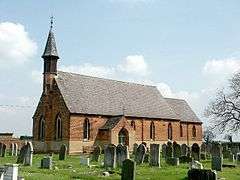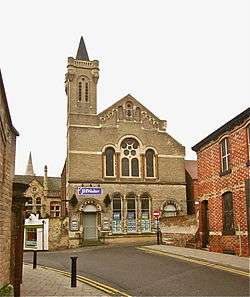William Mortimer (architect)
| William Mortimer | |
|---|---|
|
Mint Street Baptist Church, Lincoln, 1870 | |
| Born |
1841/2 Terrington, Yorkshire. |
| Died |
7th. February 1913. Probably Lincoln |
| Nationality | English |
| Alma mater | Christs Hospital School, Lincoln |
| Occupation | Architect |
| Practice | Drury and Mortimer. After c.1895 William Mortimer and Son. |
| Buildings | Lloyd’s Bank, Lincoln. Lincoln Liberal Club. |
William Mortimer (1841/2-1913) was an architect working in Lincoln from around 1858. He also played for the Lincolnshire County Cricket team.
Career.
Mortimer was born in Terrington, Yorkshire in 1841/2 [1] and educated at the Christ’s Hospital School, Lincoln and by 1858 was working as an architect in Lincoln.[2] He played cricket for Lincolnshire against the All England Team in 1861 and 1862.[3] From about 1870 or earlier he was in partnership with Michael Drury as ‘‘Drury and Mortimer’’ until about 1880. After about 1895 he was in partnership with his son as ‘‘W. Mortimer and Son’’. In 1889 he had his offices in Unity Square, off the Broadgate in Lincoln[4] and in 1896 the Address is given as the Oddfellows Hall. From c.1895 he was working with his son William M. Mortimer. Later his son formed the partnership ‘‘Mortimer and Davis’’ of Lincoln which lasted until 1935. The contract ledgers seem to indicate two offices between March 1905 and May 1911, with presumably his son undertaking developments in Colchester and Romford, Essex. Work in Norfolk and Huntingdon is also recorded. No entries are recorded between August 1914 and February 1920.[5]
Family
He married Frances Harrison of Boston (her father was a baker and corn merchant) in Boston in 1866. They lived at Walnut Cottage, Motherby Hill, Lincoln.[6]
Architectural Work
Drury and Mortimer

- Lincoln Mint St Baptist chapel. Now converted into the offices of Walters Estate agents, An example of Romanesque revival architecture in a debased Italianate Romanesque revival style in 1870.[7]
- North Kyme, St Luke's church. Red brick church built in 1877
- South Hykeham Restoration of church.
Work of William Mortimer

- Saltfleetby St Clements. Rebuilt church in 1885 on new site.[8]

Work of W. Mortimer and Sons
- Asterby church. Restoration work, c1900.[9]
- Liberal Club, Saltergate, Lincoln. 1890.[10]
- Baptist Sunday School, Mint Street, Lincoln 1897. Attached to the Baptist Church [11]
- 65 Canwick Road, Lincoln. The offices of Fambrini & Daniels, artificial stone and terracotta manufacturers.
- Grandstand for the Lincoln Racecourse 1897.[12]
- Lloyd’s Bank, High Street/ St Benedicts Square. 1901-3. Stone facade. Described in Pevsner as ‘‘Dehydrated Geogian Baroque’’- it is actually quite good and more Classical than normal Edwardian Baroque Revival architecture.[13]
- Oddfellows Hall, Unity Square, Broadgate, Lincoln.[14]
- Market Rasen. Lincoln Co-operative Society, Union Street, 1897.[15]
- Scunthorpe. Normanby Road. The Crosby Arms in ‘‘Brewer’s Tudor’’.[16]
Literature
- Antram N (revised), Pevsner N & Harris J, (1989), The Buildings of England: Lincolnshire, Yale University Press.
References
- ↑
- ↑ Sir Francis Hill (1974),Victorian Lincoln, Cambridge U.P., pp 63 and 303.
- ↑
- ↑ Kelly’s Directory of Lincolnshire, 1889, pg 534
- ↑ Architects' contract ledgers
- ↑
- ↑ Antram N (revised), Pevsner N & Harris J, (1989), The Buildings of England: Lincolnshire, Yale University Press.pg 521-2.
- ↑ “Antram” (1989), pg 620.
- ↑ “Antram” (1989), pg 108.
- ↑ “Antram” (1989), pg 521.
- ↑ “Antram” (1989), pg 522.
- ↑ “Antram” (1989), pg 509.
- ↑ “Antram” (1989), pg 524.
- ↑ “Antram” (1989), pg 556.
- ↑ “Antram” (1989), pg 521.
- ↑ “Antram” (1989), pg 636.
External links
| Wikimedia Commons has media related to William Mortimer (architect). |
